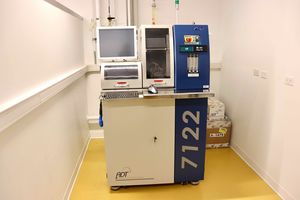Difference between revisions of "ADT 7100 Dicing Saw"
Jump to navigation
Jump to search
| Line 35: | Line 35: | ||
* [https://repository.upenn.edu/scn_sop/17/ QNF SOP] | * [https://repository.upenn.edu/scn_sop/17/ QNF SOP] | ||
* [https://urldefense.com/v3/__https://lnf-wiki.eecs.umich.edu/wiki/ADT_7100_Dicing_Saw__;!!IBzWLUs!CxAen2043kyzzuVvC2TIklv-FS-rzC3b7KXgT_PfrFmrvE1Yxcqru6MgJTXBi5GMrvk$ Lurie SOP] | * [https://urldefense.com/v3/__https://lnf-wiki.eecs.umich.edu/wiki/ADT_7100_Dicing_Saw__;!!IBzWLUs!CxAen2043kyzzuVvC2TIklv-FS-rzC3b7KXgT_PfrFmrvE1Yxcqru6MgJTXBi5GMrvk$ Lurie SOP] | ||
| − | * [https://drive.google.com/file/d/1OaMUS65IQB3LxHb5uDhZkGpUV1rOP8GU/view?usp=sharing Wafer Mounting Video | + | * [https://drive.google.com/file/d/1OaMUS65IQB3LxHb5uDhZkGpUV1rOP8GU/view?usp=sharing Wafer Mounting Video (Lurie Lab, University of Michigan)] |
* [https://alliance.seas.upenn.edu/~qnf/wiki/index.php?title=File:DicingSelection.png Dicing Blade Selection - No blade part numbers] | * [https://alliance.seas.upenn.edu/~qnf/wiki/index.php?title=File:DicingSelection.png Dicing Blade Selection - No blade part numbers] | ||
* [https://upenn.box.com/s/72vdy8fglkagye8pc1at2fdlg9bvpfqc Material Dicing Guide] | * [https://upenn.box.com/s/72vdy8fglkagye8pc1at2fdlg9bvpfqc Material Dicing Guide] | ||
Revision as of 14:00, 21 June 2022
 |
|
| Tool Name | ADT 7100 Dicing Saw |
|---|---|
| Instrument Type | Back End |
| Staff Manager | Eric Johnston |
| Lab Location | Singh 104 |
| Tool Manufacturer | Advanced Dicing Technologies (ADT) |
| Tool Model | 7122 |
| NEMO Designation | {{{NEMO_Designation}}} |
| Lab Phone | none |
| SOP Link | SOP |
Description
Workhorse dicing saw with precision dicing and alignment system. This is an automated tool with a 2″, DC-brushless, 1.2 kW, Front-mounted, Air-bearing Spindle (60 krpm Max.), with closed-loop turntable, and is optimized for multi-angle dicing of thin, tight tolerance products up to 200 mm x 200 mm.
Applications
- Dicing of Si wafers
- Dicing of glass wafers
- Dicing of sapphire wafers
Important Considerations
- Main cause of broken blades is having the saw descend directly onto the sample. The solution to this is to make sure your sample is centered as much as possible, and to have 10mm of over travel.
Resources
ADT Contacts:
- Bob McCort (semi-retired): rmccort@adt-co.com
- Bob Smith, process specialist: rhsmith@adt-co.com